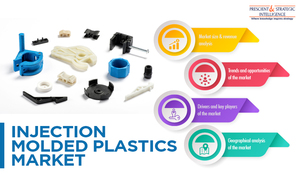بلوق الرئيسية
» جنرال لواء
» Automotive Sector Deploys Injection Molded Plastics for Lightweight Vehicles
- الكلمات - #Research #Injection Molded Plastics Market #Injection Molded Plastics #Chemicals
-
- آخر تحديث ١٥ أبريل، ٢٠٢٢ تعليق ٠ , ٢٥٠ views, ٠ مثل
- United States - احصل على الاتجاهات
More from Aryan Kumar
More in Politics
Related Blogs
أرشيف
Automotive Sector Deploys Injection Molded Plastics for Lightweight Vehicles
منشور من طرف Aryan Kumar
١٥ أبريل، ٢٠٢٢
الجسم
With the increasing disposable income of people, the sale of automobiles is rising. This is driving carbon emissions, as most of the vehicles in operation run on gasoline, diesel, and compressed natural gas or liquefied petroleum gas. Although electric vehicles are being strongly promoted by governments around the world and their penetration is increasing, they are just not replacing conventional automobiles fast enough. This is because EVs have constraints related to their speed and driving distance.
As a result, P&S Intelligence expects the injection-molded plastics market revenue to rise from $283.5 billion in 2016 to $496.2 billion by 2025, at a 6.0% CAGR between 2017 and 2025. This will be because of the increasing usage of plastics in automotive manufacturing, with the aim to reduce the vehicle weight. Making the automobile lighter can lead to a significant decrease in its greenhouse gas (GHG) emissions and a considerable increase in its mileage.
Since automotive parts need to be in a variety of shapes and sizes, they are being created via the injection molding process, wherein molten plastic is injected into a mold to create the desired shape and size. Moreover, this technique allows for the cost-effective creation of parts on a large scale, which allows automakers to save costs and, ultimately, keep the overall vehicle purchase price low. There are a host of emission regulations implemented around the world that have impelled automakers to reduce the vehicle weight.
Moreover, Asia-Pacific has been the dominant injection-molded plastics market till now. The region produces the most automobiles in the world, led by India, Japan, South Korea, and China. Similarly, the food and beverage and packaging sectors in the region are growing with its rising population and disposable income. Another sector that is expanding in the region is consumer electronics, which is another major consumer of injection-molded plastics. Further, the region is home to a lot of plastic producers, which leads to an easy availability of such materials.
Hence, with the growing automotive and food and beverage sectors, the demand for injection-molded plastics will rise.
As a result, P&S Intelligence expects the injection-molded plastics market revenue to rise from $283.5 billion in 2016 to $496.2 billion by 2025, at a 6.0% CAGR between 2017 and 2025. This will be because of the increasing usage of plastics in automotive manufacturing, with the aim to reduce the vehicle weight. Making the automobile lighter can lead to a significant decrease in its greenhouse gas (GHG) emissions and a considerable increase in its mileage.
Since automotive parts need to be in a variety of shapes and sizes, they are being created via the injection molding process, wherein molten plastic is injected into a mold to create the desired shape and size. Moreover, this technique allows for the cost-effective creation of parts on a large scale, which allows automakers to save costs and, ultimately, keep the overall vehicle purchase price low. There are a host of emission regulations implemented around the world that have impelled automakers to reduce the vehicle weight.
Moreover, Asia-Pacific has been the dominant injection-molded plastics market till now. The region produces the most automobiles in the world, led by India, Japan, South Korea, and China. Similarly, the food and beverage and packaging sectors in the region are growing with its rising population and disposable income. Another sector that is expanding in the region is consumer electronics, which is another major consumer of injection-molded plastics. Further, the region is home to a lot of plastic producers, which leads to an easy availability of such materials.
Hence, with the growing automotive and food and beverage sectors, the demand for injection-molded plastics will rise.
الصور
خريطة
-
المواقع على MyWorldGo
معلومات الموقع
- موقعك: United States - احصل على الاتجاهات
- العنوان المنسق: United States
- بلد: United States












تعليقات